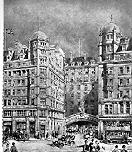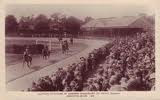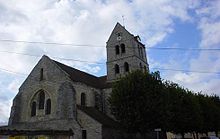Yesterday I went to see George Russell (AE) in the morning at Plunkett House - 3rd floor, editorial offices of The Homestead.
The Irish Homestead was the weekly publication of the Irish Agricultural Organisation Society (IAOS). It was founded in 1895 by Horace Plunkett. The aim of the paper was to push the objectives of the IAOS, setting up dairy co-operative societies and co-operative banks, and introducing co-operation among Irish farmers by proving the benefits obtainable through more economical and efficient management. The newspaper was originally edited by Thomas Finlay, S.J., then by T. P. Gill and H. F. Norman. This publication was the first to publish James Joyce with his short story "The Sisters" in 1904. It ceased publication in 1918, but was afterwards revived in October 1921. In 1923 it was amalgamated with the Irish Statesman, and in this format it continued, under the editorship of George William Russell, until 1930.
Susan Mitchell there as sub-editor.
Susan Langstaff Mitchell (1866 – 1926) was an Irish writer and poet, known for her satirical verse.
She was born in Carrick-on-Shannon, County Leitrim, one of eight children of Michael Thomas Mitchell. Her father was manager of the Provincial Bank there. He died when she was six years old and she was sent to Dublin to be educated, while her mother, Kate (née Cullen, a prominent family from Manorhamilton), moved to Sligo. She lived in Dublin with two comfortably-off aunts. In 1900 she travelled to London for treatment of a hearing problem and stayed with John B. Yeats and his family. After her return to Dublin she worked as a journalist and became assistant editor of the Irish Homestead, under George Russell. She contributed essays, reviews and drama notes and became acquainted with William Butler Yeats, Padraic Colum, George Moore and others. She lived with her sister Jane (Jeanny), an actress, and mother in Rathgar. Her mother dictated her memoirs to her, which were later published. She published her first book of poems in 1908. In 1926 she became sub-editor of the Irish Statesman, again under George Russell.
Immortality
Age cannot reach me where the veils of God have shut me in,
For me the myriad births of stars and suns do but begin,
And here how fragrantly there blows to me the holy breath,
Sweet from the flowers and stars and the hearts of men, from life and death.
We are not old, O heart, we are not old, the breath that blows
The soul aflame is still a wandering wind that comes and goes;
And the stirred heart with sudden raptured life a moment glows.
A moment here – a bulrush’s brown head in a gray rain,
A moment there – a child drowned and a heart quickened with pain;
The name of Death, the blue deep heaven, the scent of the salt sea,
The spicy grass, the honey robbed from the wild bee.
Awhile we walk the world on its wide roads and narrow ways,
And they pass by, the countless shadowy groups of nights and days;
We know them not, O happy heart, for you and I
Watch where within a slow dawn lightens up another sky.
- Susan Mitchell (1866-1926)
For me the myriad births of stars and suns do but begin,
And here how fragrantly there blows to me the holy breath,
Sweet from the flowers and stars and the hearts of men, from life and death.
We are not old, O heart, we are not old, the breath that blows
The soul aflame is still a wandering wind that comes and goes;
And the stirred heart with sudden raptured life a moment glows.
A moment here – a bulrush’s brown head in a gray rain,
A moment there – a child drowned and a heart quickened with pain;
The name of Death, the blue deep heaven, the scent of the salt sea,
The spicy grass, the honey robbed from the wild bee.
Awhile we walk the world on its wide roads and narrow ways,
And they pass by, the countless shadowy groups of nights and days;
We know them not, O happy heart, for you and I
Watch where within a slow dawn lightens up another sky.
- Susan Mitchell (1866-1926)
Russell very untidy. Longish beard. Gleaming glasses. He said he could not stand the dullness of the walls. So he had given 4 afternoons to painting the whole of them with figures and landscapes.
 |
| George William Russell |
In the death this week of George William Russell, "AE," as he was known in the literary world, Ireland lost a great national mind and the world has lost one of its most prolific pens.
George William Russell was the son of a middle-class Irish family of County Armagh, and received only a public school education. His quality as a writer were the inherent imagination of his race, the unplumbed depths of the mystic, the unbounded mind of the dreamer and an intense national pride. Something of the power of those qualities when combined as "AE" combined them can be seen from the long life that has attended his works. His fist book of poems, "Homeward: Songs by the Way," published in 1894, has never really disappeared from circulation.
It was Ireland more than the Irish that Russell really loved. It was Ireland he painted - another highly developed natural talent, which he used as a "recreation" when words grew heavy and tedious to work with. And it was Ireland he sought to unify in a great national scheme of cooperative societies. For many years between two careers as an editor, "AE" buried his hatred for travel and toured Ireland, educating the farmers and the county folk along the lines of cooperatives effort, forming in various communities cooperative grocery stores, cooperative dairies and markets, and similar enterprises.
Among his outstanding literary adventures, there were terms of office as editor of the Irish Homestead, an agricultural journal; the Theosophist, which he wrote to a great extent all by himself under various, pen-names. Frequently, when money was scarce, he would use pseudonyms to engage himself in a vigorous argument for the benefit and enlightenment of unknowing readers. His last editorial chair was with the Irish Statesman after its merger with the Irish Homestead, and for seven years until 1930 he managed to keep it alive despite an intensely high intellectual outlook.
As was the case with many of his characteristics, his wit was typically Irish, and he possessed a stinging tongue through which he invariably voiced his criticism of his friends, without, it can be said, losing any of them. A classical example still much quoted was This comment to George Moore, the Irish novelist, during a tea-hour discussion, of a new Moore novel. "You," "AE" told Moore, "are like a porcupine rubbing yourself against the bare legs a child, unconscious of what you do."
For "AE", in spite of the fact that he knew of the musical, qualities of his deep voice, and was intensely proud of it, one of the greatest ordeals was to read his own poetry. He disliked America because of having to read his poetry when he got there, more than because he had to travel to reach it. But it was through reading his poems that a great mass of his follower came to know him and to appreciate more fully what "AE" meant them to appreciate in all his praises of his one great love, his Ireland. - The Toronto Globe, July 19, 1935.
It was Ireland more than the Irish that Russell really loved. It was Ireland he painted - another highly developed natural talent, which he used as a "recreation" when words grew heavy and tedious to work with. And it was Ireland he sought to unify in a great national scheme of cooperative societies. For many years between two careers as an editor, "AE" buried his hatred for travel and toured Ireland, educating the farmers and the county folk along the lines of cooperatives effort, forming in various communities cooperative grocery stores, cooperative dairies and markets, and similar enterprises.
Among his outstanding literary adventures, there were terms of office as editor of the Irish Homestead, an agricultural journal; the Theosophist, which he wrote to a great extent all by himself under various, pen-names. Frequently, when money was scarce, he would use pseudonyms to engage himself in a vigorous argument for the benefit and enlightenment of unknowing readers. His last editorial chair was with the Irish Statesman after its merger with the Irish Homestead, and for seven years until 1930 he managed to keep it alive despite an intensely high intellectual outlook.
As was the case with many of his characteristics, his wit was typically Irish, and he possessed a stinging tongue through which he invariably voiced his criticism of his friends, without, it can be said, losing any of them. A classical example still much quoted was This comment to George Moore, the Irish novelist, during a tea-hour discussion, of a new Moore novel. "You," "AE" told Moore, "are like a porcupine rubbing yourself against the bare legs a child, unconscious of what you do."
For "AE", in spite of the fact that he knew of the musical, qualities of his deep voice, and was intensely proud of it, one of the greatest ordeals was to read his own poetry. He disliked America because of having to read his poetry when he got there, more than because he had to travel to reach it. But it was through reading his poems that a great mass of his follower came to know him and to appreciate more fully what "AE" meant them to appreciate in all his praises of his one great love, his Ireland. - The Toronto Globe, July 19, 1935.
Russell said he had said to Yeats that Moore's "Hail and Farewell" was the finest biography Yeats would ever have.
Hail And Farewell! by George Moore is a three volume memoir of Moore’s time in Dublin in the decade prior to the outbreak of the Great War and the Irish Revolution. His observations on the great and the good of Irish society whom he encountered upset many of his friends. Moore was an anti-clerical, agnostic, modernist bohemian excluding him from the mainstream of Irish political, religious and literary thinking. However he played a part with his friend Edward Martyn in the Irish Literary Revival. Ireland was then dominated by a stand off between two conservative forces; the declining Unionist Protestant Anglo-Irish elite and the rising nationalist Irish Catholic middle class. Moore was simultaneously out of step with both British imperialist and Irish Catholic nationalist moral pieties and hypocrisies he cared little for. The work is a revealing insight into Irish life before it was turned upside down by sweeping social and political change. Moore said of the work that ‘ Dublin is now divided into two sets; one half is afraid it will be in the book, and the other is afraid that it won't.’ Moore Hall, Co. Mayo hosted figures such as Lady Gregory and W. B. Yeats.
<http://archive.org/details/hailfarewell03moorrich>



















